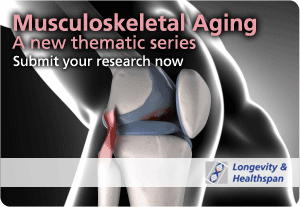Age-related decline in the function of musculoskeletal tissues is a major contributor to both poor quality of life and loss of independence in a significant number of older individuals.
Longevity & Healthspan has launched a new thematic series on Musculoskeletal Aging, which brings together expertise in different tissues within the musculoskeletal system. The series aims to increase our understanding of the aging processes of the whole musculoskeletal system and address how these processes may be ameliorated or prevented.
The first article by James Cobley  et al. presents research on how age and habitual activity level can influence the levels of PARP-1, cleaved-PARP-1 and PARG – three proteins involved in DNA repair, and cell death responses to stress and genotoxic insults. The authors compare muscle biopsies from old and young exercise-trained and untrained individuals, at rest and following a single bout of high-intensity exercise. Looking at the expression levels of these three proteins they identify that lifelong exercise may slow the progression towards a chronically stressed state in skeletal muscle. In addition, habitual training in young subjects may provide protection against potentially damaging, exercise-induced stress response. These results suggest that habitual exercise training could protect the aging genome – though this is something that requires further investigation.
et al. presents research on how age and habitual activity level can influence the levels of PARP-1, cleaved-PARP-1 and PARG – three proteins involved in DNA repair, and cell death responses to stress and genotoxic insults. The authors compare muscle biopsies from old and young exercise-trained and untrained individuals, at rest and following a single bout of high-intensity exercise. Looking at the expression levels of these three proteins they identify that lifelong exercise may slow the progression towards a chronically stressed state in skeletal muscle. In addition, habitual training in young subjects may provide protection against potentially damaging, exercise-induced stress response. These results suggest that habitual exercise training could protect the aging genome – though this is something that requires further investigation.
The series is edited by the journal’s co-Editor-in-Chief, Janet M Lord, and the first articles have been invited by Commissioning Editor, Aphrodite Vasilaki. Unsolicited submissions are also encouraged, so submit your manuscript via the journal’s online submission system or email editorial@longeviytandhealthspan.com
Comments